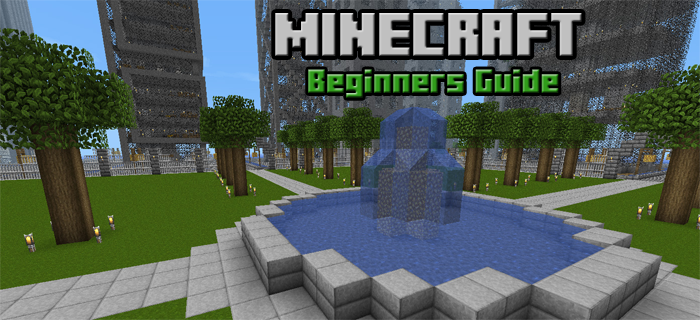Minecraft for beginners: surviving your first nights
Our first writer SergeT3 already went into sweeping detail about how to succeed in Minecraft. I would be remiss to try and retread the ground he’s so carefully cultivated. In blanketing the topic, he couldn’t go into the minute details that sometimes mean the difference between life and death.
That there’s my job, and I intend to do it.
The house that [your name here] built
Punch trees, get wood, build house. In that order.
As Serge mentioned, but needs restating, a house will keep you alive until you’ve created means of surviving yourself. In today’s Minecraft, however, things are somewhat different. There are many different environments a new spawn might find himself in, and in all of mine, it’s been in a forest near some water.
Being around so much wood, sand, and water has advantages, but poses some glaring problems. Gathering wood takes time, as does leveling the ground for your home’s foundation. If no sheep spawned near you, a bed is out of the question, and nighttime without proper equipment is a death sentence. How do you build a house if there’s not any time to do it?
Your first mineshaft
Simple: your first house is a hole in the ground. Harvest what wood or other building materials you desire, and start work when the sun’s still in the sky. Even as it begins to set, keep those wooden tools a-workin’, but once you hear the telltale sounds of spiders, skeletons and the almighty creeper, there’s only one direction you should go. Straight down.
About ten blocks beneath your home is enough. Just remember to make your tunnel about three or four empty spaces to a side so some light shines in. Until you find coal, darkness is not your only enemy. It breeds them.
Sometimes you’ll find coal right away, other times it seems the rarest element on the planet.* The moon gives off enough ambient light that you can dig in a few different directions for a fair distance. Regardless of your coal yield, when you reach your visibility limit, day will probably be dawning again. If it hasn’t, start making your way topside anyway, digging in to the sides of your mineshaft until the light pours in from above.
Light for your life
Once back topside, you’ll probably want to explore the area around you a bit. Look for sheep first thing, as beds save a ton of time. More importantly, get a general feel for the block composition of the area. For example:
- How much wood, sand, and dirt can you conceivably move and craft in a day’s time?
- How many animals are there within a short distance?
- How high up is your house, and should you make it higher?
Answer these questions with the first half of your day.
Basic geography in mind, take a few minutes to light your house like a [holiday plant name here]. This should keep monsters away if there’s enough light, but if you have come to the surface far from home, finding your way back will be much easier.
If you go too far afield in your mining operation and cannot see your house, regardless of the time, start attempting to retrace your steps. Use the sun as a guide and try making a trail of torches between your mineshafts. Until you find redstone to use as, among other things, directional markers, having a visual lead to and from your house is a godsend.
Once your house has a roof, you’ll want to light the insides as well, but by this time you’ll have other concerns.
Through the tunnels, dark and deep
With or without a finished house, you’ll find yourself exploring the rocky underground more often than you do basking in sunshine. Initially, explore as far afield as you dare, but always know the basic way back to your house. The easiest way to do this is with torches. As you dig, put a torch or two on the walls. If you go down, make an impromptu stairwell for easy access back up. Create a simple system for torch placement so you know which way to turn at a fork in your path. Light is your greatest ally when you are relatively unarmed, so use it liberally.
Caverns of plenty, caverns of death
Deep below your initial mineshaft, and littered throughout the world, are huge caverns filled with usable materials and deadly hazards. This being a guide to your first few days and nights in Minecraft, I suggest you only make note of how you reached the caverns. Until you’ve created some iron armor and weapons and stockpiled plenty of back-up crafting blocks, steer clear.
The brave and foolhardy among you will no doubt ignore this warning, so here’s my best advice to you.
First: be prepared to die.
Second: know that when you die, there’s a 98% chance all your stuff will fall into a lava flow. The remaining 2% is it falling into the Nether through a means I cannot begin to understand.
Third, settle on an escape route every five minutes. Analyze your surroundings as you explore and identify the quickest way out of trouble. Have some cobblestone ready to block the way you came, and enough torches to get you to the surface or back to your mine. Have several spare axes, picks, and shovels handy at all times.
Lastly, know where the creepers are coming from. They can make for handy exit-making-bombs so long as you know how to use them.
Tune in next time when I’ll cover how to best make your house a home. Or at least, how I did it.
*After you found the first vein, you’ll never have space to keep it all.








BROFIST
BROFIST RETURNED!
I’m somewhat disturbed that you didn’t mention ‘never dig straight down’.
It sounds trivial, but I can only keep repeating that if you ever dig as much as a single block straight down, you will die. You will get sandviched in between three creepers and two skeletons and die. You will drop into a chasm without enough blocks and tools to get back up and die. You will fall to your death and die. You will find yourself moving very quickly relatively to a lava lake in an uncomfortably straight direction (yes, that DID happen to me. I managed to grab a ledge on the way down, but HELL was it a scare.) And, did I mention that you’ll fall into a dark cave and die?
Also, as a MC veteran, I can confirm that everything standing here is true. While I’m not a wussie who hides below his becoming home at night, (rather one who stands in a 1x1x2 cabin with just a door all night,) it’s very easy to overjudge your capabilities. You can basically toss anything up to iron swords and armor is very hard to get hold of. Leather is the easiest to acquire, even though a full set can still take an exorbitant amount of time, but it drains faster than you’d expect it to.
That’s why I recommend that, until you get yourself a diamond blade and have skinned enough cows to build a slightly morbid Mount Rushmore out of the piled up carcasses, you avoid fighting anything if possible. Yes, it’s tempting to use those 27 iron you scratched off of mother nature’s gut cavity walls on a sword and armour, but what are you gonna use that for? Breaking it with fall damage from your reckless mine jumps? Actually, that’s not possible anymore, but nevermind.
The point is, all mob drops (except spiders, but those are fairly easy to kill) are useless until and perhaps even in the late game, so don’t bother. Make an iron sword for self defense and go back to digging for diamonds.
From now on I’m just going to assume you are an expert at every game ever.
Note that I don’t suggest digging down more than a few blocks. You’re right that going down too much will kill you every time, but in my experience, around ten blocks or so will get you to a small mineshaft. If not, it’s a safe distance to start making your own. Ideally, you won’t actually be making your own mineshaft, as there’ll be open ones within spitting distance of your spawn or where you build your house. Keeping these in mind alleviates the need to dig much at all.
The only reason I suggest digging down to protect yourself is to get you experienced with the game. Mining is a constant, and even if you don’t spend much time at all directly beneath your house, you’ll always have a small cavern that you can link your larger mines to. Provided of course you have the directional knowledge to do so.
I’ll keep your combat tips in mind as I continue my journey, and hopefully I’ll have my house done in the next couple days so I can share with you all. It won’t be spectacular, but I think it looks like a good beginners house. Hopefully I can make those dungeons cool looking.
Yes, I guess digging down a small distance if you are at surface level is fairly safe.
Well, I guess if you’re hunting spiders, you might want to pick up the occasional skeleton that presents itself too, though don’t get cocky. Even when you manage to get one isolated and with enough space/cover (how ironic that both can be utilised to defeat them), they are tough opponents the worse your gear is, and once again, you’d only really want the arrows since crops can just grow while you’re out digging. Thinking about it, yeah, killing anything but spiders is fairly pointless as you can also craft arrows out of the mountains of flint you’ll have dug out if you KFC (kill the freakin’ chicken) like a good boy.
Aw, I’m not an expert at everything. Well, I guess I do have a 90% win rate at every AC game ever (the remaining 10% being due to oSB and glitches), and I did get the ranking of professional in AC3 after like literally four matches, but I couldn’t… well, I guess I CAN recite all of the Horde’s WoW out of memory except for Grindaria, occasionally down to what specs the quest rewards are good for. And maybe I did get a Dream Puppets build without any direct mill or even any sorceries to work better than the cookie cutter build…
Yeah, I guess I’m rightfully called Doctor Awesome. It’s how the Doctor rolls. Pick up a new game, suck at it for thirty minutes, dig in, kick ass, repeat.
Concerning houses, once again, the game wants you dead, so just don’t get greedy. Since you can move everything with wonderful physics that’d make a furious Stephen Hawking jump out of his chair just to slap you, it’s always proficient to do something you can actually finish first and improving on that rather than having to spend the night in a tiny hole or cabin because you started out with much more than you could gather the wood for. Hell, put in sand and dirt. At first, it all is just function.
Another thing, safety! One torch on each side of the spawner! Assuming you mean dungeons in the game’s terms, anyhow. In case of caves, you’d be surprised what flair occasionally making a block stick out or cave in can create. Portal did it like that. Now you wouldn’t argue with the game version of divine nectar served by baby Jesus himself, would you?
As a veteran of the great opportunities opened up by alchemy, I’d also like to offer up my two cents on minecraft.
It would be a crime not to recognize the power of early provisions. Though you may not need, or indeed want it, early random items such as: mushrooms,grass/pumpkin/watermelon seeds, clay, spider eyes, etc. can be utilized later in your adventure for a wide variety of things, including my particular subjects of love; food and alchemy.
Culling the grass and a small amount of careful trench digging can divert water from the ocean to a fast beach-side farm. This early in the game, you can either be gifted more animal meat and hides than can be skinned and consumed on the whole island of Far Cry, or you can be dropped in an area comparable to the Sahara desert; uninhabitable and daunting. These small wheat/watermelon farms can save your life when you start to get hungry, as well as provide for you until you are able to afford the materials for a fishing rod, another easy means of acquiring food.
The plus of fishing is that, by utilizing any lily pads you find on the water, you can swim out to the middle of a large body of water, make yourself a platform, and fish until the dawn. With no hostile water mobs yet added to the game, it’s a safe alternative to mining the night away. Failing lily pads, boats are the second obvious option. With fish come a somewhat insubstantial but satisfying food source, for both you and any ocelots you meet in the jungle biomes. Need I mention that ocelots ward off creepers?
Early provisions are very useful for the progression of your adventure. They can hold you over in the present or set you up for many items in the future, such as potions which can increase your movement speed, cause instant damage, poison your enemies, and so, so much more.
Side note: While many of my friends struggle with finding watermelon seeds early, I always seem to stumble upon them early in my adventure so I consider them random early items.
One tip for survival mode:
If in an emergency, dig a hole 4 layers deep, jump inside and cover, if possible with glass. If glass isn’t possible then use dirt and light torches or sit out the night in the dark.
Note… this isn’t intended to serve as a home. Just if zombies are all around you and you’re too far from your real shelter without weapons.
If you Spawn in a desert: do not be afraid to sprint around a little. just because it’s a desolate wasteland doesn’t mean there aren’t any villagers about. I as a Veteran of the crafted mines have spawned in a desert countless times (and completed the game on hardcore in one). Villages seem to spawn in a desert biome often, even small ones. and with villages comes 4 starting torches possible iron and armor, DIAMONDS, and saplings. Not to forget countless carrots, potatoes and bread, all plant-able. Even with the new update I’ve found that desert temples are extremely common and that they contain plenty of bones(bonemeal), rotten flesh(food), and iron, gold, or even Diamonds. don’t give up on the deserts, they are not as in-hospitable as they seem. if your walking around in a desert biome don’t be afraid to dig down in places that are like bowls, those are indications that either A. dungeon or B. mineshaft or tunnel.